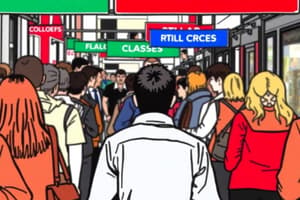Podcast
Questions and Answers
Socioeconomic class only considers an individual's income level.
Socioeconomic class only considers an individual's income level.
False (B)
People in the upper class typically have less job security than those in the working class.
People in the upper class typically have less job security than those in the working class.
False (B)
Social mobility refers to the ability to change one's socioeconomic status.
Social mobility refers to the ability to change one's socioeconomic status.
True (A)
Income inequality is decreasing in many countries today.
Income inequality is decreasing in many countries today.
Intersectionality means that socioeconomic class can be influenced by other identities like race and gender.
Intersectionality means that socioeconomic class can be influenced by other identities like race and gender.
Flashcards are hidden until you start studying
Study Notes
Definition of Socioeconomic Class
- A social hierarchy based on a combination of economic status, education, and occupation.
- Influences individuals' access to resources and opportunities in society.
Key Components
-
Economic Status
- Income levels: earnings from work, investments, etc.
- Wealth: overall assets owned, including property and savings.
-
Education
- Attainment: levels of education completed (high school, bachelor's degree, etc.).
- Quality of education: differences in school resources and opportunities.
-
Occupation
- Job types: skilled vs. unskilled labor, professional roles, etc.
- Job stability and security: affects economic mobility and status.
Class Categories
- Upper Class: High income, significant wealth, often involved in elite professions or business ownership.
- Middle Class: Moderate income, typically well-educated, often in stable jobs; often splits into upper-middle and lower-middle.
- Working Class: Lower income, often in manual labor or service jobs; may have less job security.
- Lower Class: Low income, often facing poverty; limited access to education and healthcare.
Social Mobility
- Refers to the ability of individuals to move between classes.
- Influenced by factors like education, job opportunities, and social networks.
Impact of Socioeconomic Class
- Affects health outcomes: access to healthcare, nutrition, and living conditions.
- Influences educational opportunities and attainment.
- Shapes social networks and community engagement.
- Affects political power and participation.
Intersectionality
- Socioeconomic class intersects with other identities (race, gender, age).
- Different experiences of class based on these intersections.
Current Trends
- Increasing income inequality in many countries.
- The role of globalization and technology in shaping job markets.
- Movement towards understanding class as a fluid and dynamic concept.
Definition of Socioeconomic Class
- A hierarchy reflecting economic status, education, and occupation.
- Shapes individuals’ access to essential resources and societal opportunities.
Key Components
-
Economic Status
- Income includes earnings from employment, investments, and other income sources.
- Wealth encompasses total assets, including property and savings.
-
Education
- Attainment refers to the highest level of education achieved, such as high school or bachelor's degrees.
- Quality is determined by resources available to schools and educational opportunities offered.
-
Occupation
- Job types distinguish between skilled (professional) and unskilled labor (manual work).
- Stability in employment influences economic mobility and overall class status.
Class Categories
-
Upper Class
- Characterized by high income and substantial wealth, often involved in elite professions or owning businesses.
-
Middle Class
- Comprised of individuals with moderate income, generally well-educated, and engaged in stable jobs; divided into upper-middle and lower-middle segments.
-
Working Class
- Defined by lower income, typically in manual or service roles with decreased job security.
-
Lower Class
- Features low income, frequent poverty, and restricted access to education and healthcare.
Social Mobility
- The capacity for individuals to transition between socioeconomic classes.
- Influenced by education, job availability, and personal or social networks.
Impact of Socioeconomic Class
- Predicts health outcomes tied to healthcare access, nutrition, and living conditions.
- Affects educational attainment and the quality of educational opportunities.
- Shapes social connections and levels of community participation.
- Significant influence on political engagement and representation.
Intersectionality
- Socioeconomic class interacts with various identities, such as race, gender, and age.
- Experiences of class differ based on these intersecting identities.
Current Trends
- Rising income inequality observed in numerous countries globally.
- Globalization and technological advancements impacting job availability and market dynamics.
- A shift towards viewing socioeconomic class as a fluid and evolving construct.
Studying That Suits You
Use AI to generate personalized quizzes and flashcards to suit your learning preferences.




